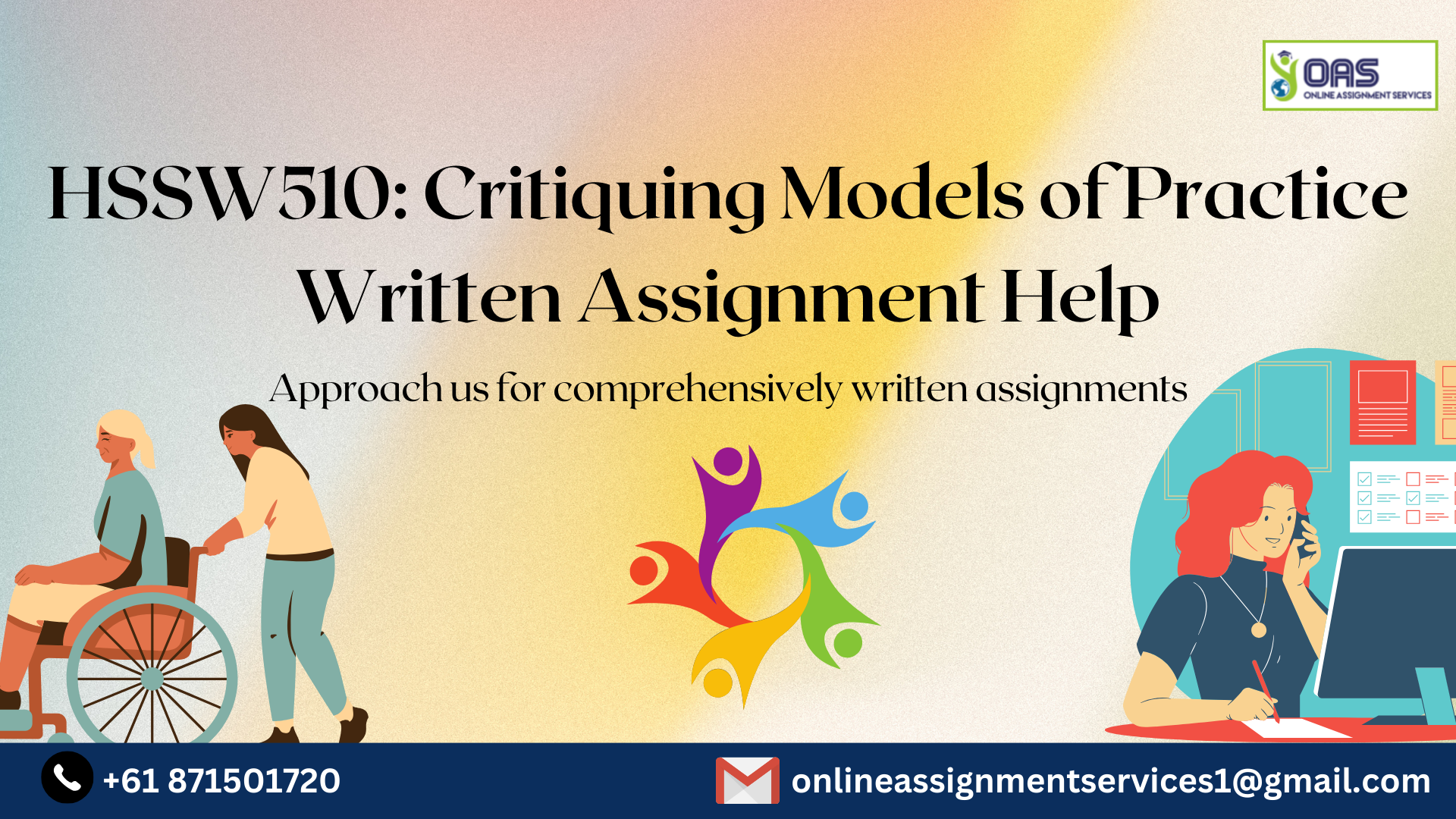HSSW510: Critiquing Models of Practice Written Assignment Help

Question
HSSW510: This is a case study-based assignment compulsory for the course Social Work Intervention Models and Skills for the University of New England. Different case studies discussing social work-related fictional scenarios from which the student is required to choose a particular case and write a critical analysis assignment for the same. The student is encouraged to choose and build on these case studies from their personal experiences and aspirations. The student must elaborate on three theories that they wish to use in their professional social work practice along with one one theory they are not likely to use. Using these theories, the student should study the service user’s needs, issues, and requirements.
Solution
The assignment solution written by our experts is based on the case study of Kellie Brown, a young girl struggling with Down’s syndrome. She resides with her mother, father, and two sisters. Kellie can accomplish most of the daily living tasks and now aspires to pursue a job to beat her boredom. However, her family feels that she is not fully equipped to live on her own and needs a companion if she decides to move out. The situation is not well at Kellie’s house as she has shown symptoms of frustration and anger bursts on her family. It is felt by her family that her condition is now impacting their family conditions immensely.
The solution presents an in-depth critical analysis of Kellie’s case by incorporating two theories of social work which will be used, and one theory which will not be used.
The assignment solution is divided into different sections- a brief introduction, an Overview, Two theories for use including Behavior therapy, Reality therapy, and one theory that will not be used- Person-centered therapy. Lastly, a brief Conclusion is provided to summarise the essay.
Introduction
In this section, a brief introduction to the field of social work as well as the aim of writing this critical analysis assignment is highlighted. Keep on reading to get insights about how our experts provide comprehensive solutions.
Social workers must have an in-depth understanding of various practice theories, approaches, and models to assess their clients’ needs, develop suitable interventions, and apply evidence-based strategies tailored to their clients’ specific circumstances (Thompson & Stepney, 2018).
This is only half of the introduction. Do you wish to read the entire part? Reach out to us on WhatsApp at +447700174710.
Overview
The solution then provides an overview section. Our experts have highlighted all the key aspects of the case study as well as the theories which are incorporated in the sections later.
Kellie faces issues such as lack of daytime activities, boredom, limited social connections, and occasional displays of anger and frustration. Therefore, what Kellie needs is some assistance with her behavioural issues and an employment opportunity which can provide her a sense of purpose and expand her social network. Considering her situation, behaviour therapy and reality therapy are two effective approaches that can address her needs. Behavior therapy is a psychotherapy that focuses on changing maladaptive behaviors and reinforcing positive ones (Masuda & O’Donohue, 2022).
Want to read more? Don’t hesitate to WhatsApp us at +447956859420.
Theory 1 for use: Behavior therapy
The first theory of social work used for the analysis of Kellie’s case is Behavior therapy. Our experts have elaborated the theory in detail along with highlighting its strengths and limitations to social work practice.
Behavior therapy is based on the premise that behavior is learned, and can therefore be unlearned or changed (Masuda & O’Donohue, 2022). It draws from the idea that behavior is influenced by the environment, and by changing the environment, individuals can change their behavior (Masuda & O’Donohue, 2022). One key feature of behavior therapy is that it is action-oriented and goal-focused, with social workers helping their clients identify specific behaviors to change and develop strategies to achieve their goals (Beck, 2020). Another key feature is that it places a strong emphasis on the role of reinforcement in shaping behavior, both positive and negative reinforcement (Beck, 2020). In addition, it is a time-limited therapy, with sessions typically lasting between 12-16 weeks (Butler et al., 2021). Therefore, behavior therapy aims to help individuals overcome maladaptive behaviors and develop new, more adaptive behaviors through a structured and goal-oriented approach. Behavior therapy has two theoretical underpinnings: behaviourismand cognitive theories. Firstly, behavior therapy is rooted into behaviourism, that emphasizes on observable behavior rather than unconscious processes or the inner workings of the mind (Watson, 2017). Behaviorists believe that behavior is shaped by the environment through reinforcement, punishment, and extinction (Watson, 2017). This theory is based on the work of B.F. Skinner, who argued that behavior can be controlled through the manipulation of these environmental factors (Sechenov et al., 2022). Secondly, behavior therapy also incorporates cognitive theories, particularly those that focus on the role of thoughts in behavior (Sechenov et al., 2022). These cognitive theories emphasize that the way a person thinks about a situation can impact how they feel and behave (Restle, 2018).
Interested in reading more about this theory? Wait no more, and call us at +61 871501720 today.

Theory 2 for use: Reality therapy
Secondly, our experts have used reality therapy to unveil all the theoretical underpinnings related to this theory and how it informs social work practice. Please read through this section to know more!
Reality therapy is an approach that emphasizes personal responsibility and focuses on the present moment rather than past events (Wubbolding, 2017). It is based on the idea that individuals can learn to make better choices and meet their needs by learning to take control of their own behavior and actions (Wubbolding, 2017). One of the key features of this approach is that the social worker collaborates with the client to identify what they want in their life, what actions they are currently taking to achieve their goals, and whether these actions are helping or hindering their progress (Thompson & Stepney, 2018). Then, they help the client to develop a plan of action that is based on their goals and values, and encourages them to take responsibility for their own actions and choices (Thompson & Stepney, 2018). Another key feature of reality therapy is that it is a present-focused approach, which means that it places emphasis on the present moment rather than dwelling on past events or traumas (Eswaran et al., 2018). Therefore, the focus is on what the client is currently doing or not doing, and what they can do differently in the present moment to meet their needs and achieve their goals. The theoretical underpinning of reality therapy is choice theory, which was developed by psychiatrist William Glasser. The choice theory posits that all human behavior is the result of choices individuals make in an attempt to satisfy their basic needs, which include survival, love and belonging, power, freedom, and fun (Fulkerson, 2020). According to Glasser, all behavior is purposeful, and people choose behaviors that they believe will help them meet their needs. All individuals have the power to make choices that either meet their needs or do not, and these choices have consequences. Therefore, Glasser believed that every individual is capable of making better choices and meeting their needs by learning to take control of their own behavior (Fulkerson, 2020).
Did you like the answer written by our experts? Let us help you as well. Reach out today- onlineassignmentservices1@gmail.com.
Theory 3, not for use- Person-centered therapy
In this next section, the assignment explains extensively one of the theories that need not be used for the social work practice. Our experts have justified this answer appropriately by highlighting how this aligns with the student’s personal goals and aspirations related to professional practice.
Person-centered therapy is a psychotherapy that is based on the belief that individuals have the ability to grow and develop in positive ways if they are provided with a supportive and empathetic therapeutic environment (Garcia et al., 2023). In this approach, the social worker listens actively and provides unconditional positive regard, meaning they accept and value the client without judgment or criticism (Garcia et al., 2023). Ultimately, the goal of this approach is to facilitate the client’s personal growth and self-actualization, thus empowering them to make positive changes in their life (Duenke, 2021). One of the key features of person-centered therapy is the social worker’s role as a facilitator who creates a supportive and empathetic environment for the client (Thompson & Stepney, 2018). In this approach, the social worker aims to build a genuine and trusting relationship with the client, and they do this by actively listening to the client and reflecting on what they say (Thompson & Stepney, 2018). By doing so, they encourage the client to express themselves freely, thereby enabling introspection and self-awareness. Another important feature of person-centered therapy is the belief that the client is the expert on their own experiences and emotions (Garcia et al., 2023). Hence, the social worker’s role is to help the client identify and clarify their own goals and values, and to support them as they work towards achieving those goals (Thompson & Stepney, 2018). This is done through non-directive counseling, which involves guiding the client towards insights and solutions without telling them what to do or how to think (Duenke, 2021).
This is only 50% of the solution. To know more, WhatsApp us at +447956859420.
Conclusion
The last part of the solution is the conclusion. Our experts provide a clear and concise summary of the findings of this critical analysis assignment.
Social workers play a crucial role in providing evidence-based counselling to help their clients achieve their personal goals and enhance their overall well-being. For the chosen agency, most of its service users have some form of intellectual disability resulting from Down Syndrome.
Only a snippet of the solution has been presented for guidance purposes here. Need assistance with the complete assignment? Give us a call at +61871501720.

